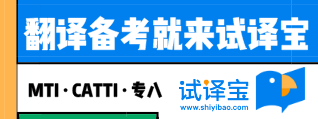各位专八考生晚上好,这里是试译君,我们今天的主题是:
听力!听力!听力!
听力一直是英语专四专八考试中的一个重要项目,也是很多同学们的弱项。改革后的听力测试题第一部分仍为讲座填空题(mini-lecture),要考生在听讲座的同时记录重要信息,然后完成填空任务。
由此可见,如何运用恰当的词高度概括要点内容及推断重要细节将逐步成为同学们考前练习的重点。
因此很多同学都会遇到这样的问题:
—-mini-lecture部分如何抓取关键词啊?
—-听到重要的内容倒是记下来了,但做题的时候完全不知道那些东西该填在哪儿怎么办啊?

无论什么困难,都有解决它的办法!
试译君为大家带来一大波听力mini-lecture答题技巧,在考前结合真题食用,帮你有效提分!相信你们都能在自己相应的问题下找到答案。
技巧1:抓主题,记实词
专八听力讲座文章通常采用总-分-总的结构,因此显得中心突出,结构清晰,层次分明。此外,开头主题、分论点或结论句中出现的关键性名词、动词、形容词等,或对某一事物特点的描述以及分述各点时的细节描述性词汇都是表达信息的主要载体。
技巧2:表示顺序或层次的词句后是要点
由于记笔记填空的材料总体来说结构清晰,因而常出现表示层次或顺序的词、词组、句子来帮助理解文章。
这类表达有:first of all, …/the second point, …/thirdly,…/Now, let’s take a look at the first point,…等等。
听音时,应对这些表达之后的信息予以注意和记录。
技巧3:表示总结的词句后是要点
记笔记填空结构层次比较清晰,因此在开始叙述和完成叙述时,通常会出现总结性或总括性的词句。
历年考题中经常出现的表示总结的结构有:to sum up, in summary, to summarize, in a word, generally speaking, finally, in general, in the end, to conclude, in conclusion, in brief, in closing, it can be concluded that…, to draw the conclusion, above all, on the whole, in short等。
技巧4:表示强调、重申的词句后是要点
文章通常不会对关键或主要的概念和观点只提一次,而会重复或多次强调说明,以突出重点信息,让听者能理解要点,从而正确理解整个讲座的内容。因此其后的内容都是记笔记的重点。
用来表示强调、重申的结构或表达有:what is the most important is, indeed, really, absolutely, of course, in other words, to put it another way, that is, in similar terms等。
[录音] If someone sticks to one topic, you can assume that he or she is really interested in it.
[参考笔记] stick to, topic, U, assume, he/she, interested
[题目] don’t shift from subject to subject
—–sticking to the same subject: signs of ____ in conversation
[答案] interest
温馨提醒:注意语法要正确,适当变换词的形式。
技巧5:逻辑关系词(转折、因果、对照、补充等)后是要点
常见的表示逻辑关系的结构有:what’s more, but, however, nevertheless, on the other hand, not only…but also…, therefore, so, as a result, consequently, hence, on the contrary, in contrast, by contrast, besides, as well, in addition, furthermore等。
技巧6:表达观点的词句后是要点
常见的表达观点的结构有:believe, maintain, consider, in my point of view, in my opinion, as I see it, in the eyes of…, as for me, as far as I’m concerned, according to等。
记笔记时应注意倾听这些观点结构之后的信息内容并做好笔记。
技巧7:表示举例的词后是要点
真题中曾出现过的表示举例的结构有:for example, for instance, such as, like, that is, namely, to illustrate, as an illustration等。
此类题型较为容易,一般会举出三个例子,只要答出一个即可,具体请在做练习的过程中体会。
技巧8:不为细节所累
边听边记时应避免记录全句,或过度纠缠于细枝末节,在理解句子整体意思的基础上记录重要的单词或短语。
技巧9:合理利用速记方法
可借鉴一些简单的符号和方法,举例如下:
1. 数学符号:如用 < 表示less than,用 > 表示more than,用 + 表示many, good等意思,用 – 表示little, few, be short of等,用 = 表示in other words或be equal to,用 × 表示not, negative, wrong,用 ∵ 表示because,用 ∴ 表示therefore等。
2. 箭头符号:用 ↑ 表示increase, add, higher,用 ↓ 表示decrease, reduce, lower,用 ↗ 表示develop,用 → 表示lead to, result in,用 ← 表示resulted from, caused by等。
3. 英语符号和缩写:用 & 表示and,用 w/ 表示with,用 w/o 表示without,用 vs 表示against,用 e.g. 表示example,用 dept 表示department,用 pres 表示presentation,用 subj 表示subject,用 max 表示maximum,用 intro 表示introduction,用 prob 表示problems等。
此外要注意在记录时要层次分明,以方便在之后答题时的笔记阅读和理解。
技巧10:学会归纳总结
填入答案时要对照自己听时的记录笔记,先确定全文的大体结构和层次,避免答非所问。值得注意的是有时要填入的词不是原文原词,需要在理解原文的基础上进行概括归纳而得出,因此答案通常不止一个。这种类型的题目较难,需要听者对原文关键词和全文的理解。
[录音] However, needs at one level do not have to be completely satisfied before needs at the next higher level come into play.
[笔记] needs, level, ×satisfied, before, needs higher
[题目] Difficult levels of needs may ____ when they come into play.
[答案] overlap、meet、mix、co-exist、interact、concur、combine
技巧11:灵机一动猜答案
即使有些词没记录下来,在答题时仍然可以通过多种方法得出正确答案,意思对即可。
1.对考题结构进行分析。考题是原文的浓缩,在结构上必然会体现原文清晰的顺序和层次结构。考生如果遗漏了其中某一层次的内容,可以先找到与之结构上并列的信息,依次判断推测。参考见下面录音。
2.对考题空格处的语法分析。考生可以通过分析,推测出空格处应填入的词的的词性和词形,然后根据前后相关信息,寻找在意义上也符合要求的答案。参考见下面录音。
3.基于自身知识。原文中的话题大部分涉及考生熟悉的领域,因此考生会具有一定的相关背景知识。如果笔记中没有可供参考的信息,听者还可以根据自己对话题的了解,预测和推断出答案。
[录音] Second, once good talkers have asked questions, they listen for answers.
[笔记] 没有记下来…
[题目] Skill to __(要填)__ for answers.
⑴ don’t shift from subject to subject
—–sticking to the same subject: signs of ___ in conversation.
⑵ listen to ____ of voice
—–If people sound unenthusiastic, then change subject.
⑶ use eyes and ears
—-steady your gaze while listening.
[解析] 根据考题可知,空格处要填入的信息和skill to ask questions, skill to laugh, skill to part的结构并列,因此确定要填入的词是能和for搭配的动词。其次, Skill to ____ for answers下的具体信息,听者可以发现这些关键词:conversation, listen, voice, listening等都和听有关,故推测空格处应填入的词为listen。
[录音] In history books, information is objective.
[笔记] 没有记下来…
[题目] Type of information
A. Information in history book is ____.
B. Information in art history is subjective.
[解析] 根据空格前后的语法结构可知要填的是形容词,在此作表语。此处比较general history和art history的不同,由下文的subjective可知,要填的形容词应该和subjective意思相对,即使笔记没有记录,也可以判断要填的词很可能就是objective。
[答案] objective
技巧12:杜绝低级错误
在填写答案时,除了确保填入的词在意思上符合题目的要求外,还要确保它们符合题目中的语法要求。因此考生应该在完成填写后,再作检查,避免犯语法等方面的错误,如词性、单复数、时态、大小写错误等。
[录音] It’s a way of sharing my thoughts with other people.
[笔记] way, sharing, thoughts, other people
[题目] Public speaking is a way for a speaker to ____ his thoughts with the audience.
[答案] share
(来源:考虫专四专八)
![1622791283632298.png 5T]$DNMG@3BZ}85I2@)9JIQ.png](/ueditor/php/upload/image/20210604/1622791283632298.png)
好啦,听力mini-lecture的12个核心技巧已经传授给大家啦!祝大家:
一战过级,和专八听力say bye~
